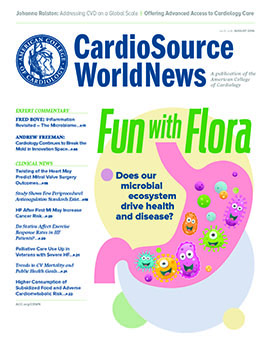Straight Talk: Cardiology Continues to Break the Mold in Innovation Space | Andrew Freeman, MD
CardioSource WorldNews | The Merriam Webster Dictionary defines innovation as “the act or process of introducing new ideas, devices or methods.” In today’s world of rapidly changing technologies and the ability to be instantly connected to people and ideas from around the globe, “innovation” is the word du jour. Everyone is vying to create, make, be “disruptive,” or “break the mold.”
You might ask why this matters to Cardiology. Cardiology as a field has always been at the forefront of innovation. Examples are many, from the invention of the first stethoscope in 1816 by French physician Rene Theophile Hyacinthe Laënnec to the advent of electrocardiography, ultrasound echocardiography, cardiac catheterization, stents and more recently transcatheter aortic valve replacement. The list of cardiovascular innovations is long and varied—so much so that in many ways innovation is built directly into the practice of cardiovascular medicine.
Many think that innovation these days is all about technology. However, while technology is a major piece of the innovation puzzle, it is not the only area where innovation is playing an important role. For example, finding and testing new ways to deliver care, allocate resources and best optimize the systems of care in which we work are important innovations that need to occur in order for practices, hospitals and clinicians to thrive in a time of immense change in the health care arena. New ideas and methods are also important to carving out a public health strategy that reduces the number of people living with or at risk of heart disease. Last, but certainly not least, innovation is behind every new discovery of a new life-saving drug, device or therapy.
Like the field of cardiology, innovation is a cornerstone of the ACC’s mission to transform cardiovascular care and improve heart health. The College has always been on the cutting edge of cardiovascular education and science, with its live programs, clinical guidelines, appropriate use criteria, and NCDR registries among the best known innovations.
More recently the College has developed a number of mobile apps designed to help clinicians at the point of care. Some of the best include a cardiovascular risk estimation tool to help manage blood lipids and a risk estimator for thromboembolism in patients with atrial fibrillation. Additionally, the ACC in July launched ACCSAP9, which incorporates the latest in educational technology in order to facilitate a more personalized education experience. For example, ACCSAP9 includes an intuitive user dashboard to quickly help users identify knowledge gaps and offer personalized content. Users can also choose to read, watch or listen to the content supplemented with hundreds of case-based questions generating custom quizzes and simulated board exams.
These are only a few examples of innovation taking place at the College. In addition, further developments in the public health space, care delivery, and the way we counsel patient behaviors are forthcoming. Earlier this year, John Rumsfeld, MD, PhD, FACC, recently joined the ACC as its chief innovation officer, Rumsfeld, former chair of ACC’s NCDR® Management Board, is working hard to bring together industry, technology and cardiologists to develop the future of our field.
The College is also working hard to give a home to many cardiologists who have moved to industry, technology, start-up or policy space, with the creation of a new Innovation Work Group. One of the most innovative things the ACC does is figure out how to connect people to develop synergies, and this group will enable the College to provide a much needed home to the innovators in medicine. More information on this new work group will be coming soon.
Thomas Edison is quoted as saying: “There’s a way to do it better—find it.” Cardiology as a profession is constantly finding ways to do things better. So too has the College. Our job is to find what’s next!
Andrew Freeman, MD, is director of clinical cardiology at National Jewish Health, and co-chari of the ACC’s Nutrition and LIfestyle Work Group.

|
Read the full August issue of CardioSource WorldNews at ACC.org/CSWN |
Keywords: CardioSource WorldNews, Organizational Innovation, Inventions, Registries, Mobile Applications, Technology
< Back to Listings
